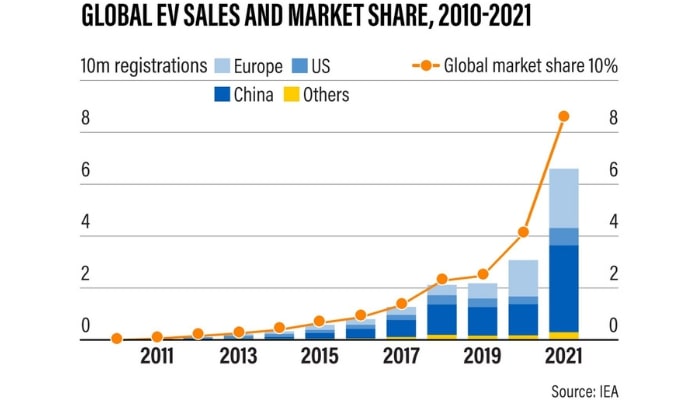Electric Vehicles (EVs) are now officially mainstream. Helped by the social media antics of Tesla owner Elon Musk, the cars are enjoying a surge in popularity that may lead to them becoming the dominant vehicle type on our roads.
With EVs dominating the headlines over the few years, here’s a look at some of the facts and figures behind their unstoppable rise.
Contents
Sales of EVs doubled in 2021
The global chip shortage made 2021 a difficult year for the car industry, but the EV sector stood apart as a key growth area. From sales of three million in 2020, the annual figure reached 6.6 million 12 months later, according to preliminary data from the International Energy Agency (IEA).

No doubt helped by the publicity campaigns of companies like Tesla – and a certain Mr. Elon Musk – the appeal of EVs is growing among consumers.
Many people see them as a viable alternative to petrol engines, while eco-friendly political agendas are pushing for an electric future. The United States and EU have both published EV adoption targets that aim to increase uptake and reduce emissions.
2021 is likely to be just the start of even more rapid growth, too, as the next fact will tell us.
There will be almost 27 million pieces by 2030
Our roads will have over four times as many electric vehicles on them within eight years, according to a forecast from S&P Global Platts Analytics.
23% higher than their 2021 prediction, S&P analyst David Capati put it down to consumer adoption momentum, and increased policy support. He also pointed out that EVs work out cheaper than petrol vehicles over their lifespan, if you consider fuel costs, subsidies and road taxes.
Going together with the rise in EV demand will be a reduction in petrol vehicle sales, known as internal combustion engines (ICE). These are set to fall gradually in the world’s major economies, the US, China and the EU, during this decade. According to Tesla Sales Statistics, tesla delivered 936,950 EV’s in 2021 and 908,580 in Q1+Q2+Q3 of 2022.
There are many more charging points
One issue with EVs has been charging stations, the lack of which deterred people from buying EVs in the past. Again, countries are combating this to make the vehicles more consumer friendly.
In the US, the Biden administration unveiled their EV charging action plan in December, which centred on the installation of half a million charging points across the nation.
The national charging network will be funded to the tune of $5 billion, with an extra $2.5 billion going toward a grant program for innovative EV-related ideas.
Retailers have got in on the act, too, offering customers the chance to charge their EVs in-store as part of customer loyalty programs.
It’s a clever marketing tactic of businesses who have found that offering these perks deepen customer relationships and build brand loyalty. Just think of online casinos offering no deposit bonuses or airlines awarding flyer points as two other examples of this system.
EV prices are set to fall
Despite the battery shortage keeping EV prices high, experts predict that it will become cheaper to buy the vehicles as we approach 2030.
Battery costs falling below $100/kWh are a chief component of this, while higher production levels will be able to satisfy demand and keep purchase costs down.
An increase in the supply of battery material, such as lithium and cobalt, due to easing COVID-19 restrictions will help, too. Indeed, the global supply chain in the post-pandemic era will be much better than it was just a year ago.
Car makers have set ‘electrification targets’
Major car makers are eager to be at the forefront of the booming EV industry. Volkswagen, already the second-largest EV manufacturer in the world after Tesla, wants half of its sales to be electric by 2030.
Their rivals are also set to up their game. The world’s biggest car producer Toyota is aiming for sales of 3.5 million a year by the end of the decade, while Ford wants 40-50% of its sales to become electric.
‘EV only’ models are the driving force behind these targets. The VW ID, Ford MachE, and Toyota Hybrid have all made waves in the car industry and continue to stimulate demand among consumers.
Consumers are warming to EVs
Public opinion toward EVs is a lot different than a decade ago. According to research from last year, four in 10 people across the world say they plan to buy one, up 11 percentage points from 2020.
Many say that increased concern about the environment would mean they would even pay a premium for an eco-friendlier vehicle, which is excellent news for EV manufacturers.
One of the main challenges for the electric car industry was convincing a sceptical public of their benefits: now it appears that EV marketers have succeeded as the industry goes from strength to strength.
